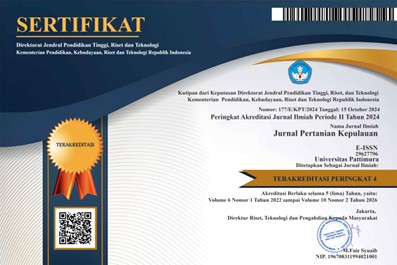Aplikasi Pupuk Vermikompos Terhadap Pertumbuhan dan Produksi Tanaman Jagung Manis (Zea mays sacharrata Sturt) serta Intensitas Serangan Hama Utamanya
Abstract
The potential for agribusiness growth of sweet corn (Zea mays Sacharata Sturt) is quite high because it is very popular and favored by consumers. The study aimed to determine the effect of the dose of vermicompost fertilizer on the growth and yield of sweet corn. The research was conducted using a randomized block design (RBD) with 3 replications, namely K0 = control, K1 = 50 g/plant, K2 = 100 g/plant, and K3 = 150 g/plant. There were 12 experimental units; each treatment was 6 plants, so the total number of plants was 72. The application of vermicompost can increase the growth and production of sweet corn plants. Based on the study's results, sweet corn's growth and yield were significantly affected by the treatment of vermicompost with a dose of 150 g. It was found that the main pest species that infected this plant were Helicoverpa armigera Hubner, Ostrinia furnacalis, and Oxya sp. It is expected that the results of the study can be used in the future regarding the application of a combination of compost and other biological fertilizers in the field.
Downloads
References
Agustina, R. M. (2022). Kajian Unsur Hara Makro Dan Mikro Pada Pertumbuhan Tanaman. In Thesis. UIN RADEN INTAN LAMPUNG.
Aulia, M. F., Rokhmat, M., & Qurthobi, A. (2020). Analisa pengaruh intensitas cahaya terhadap pertumbuhan bibit tanaman cabai dalam ruangan tertutup dengan kelembaban tetap. E-Proceeding of Engineering, 7(2).
Dwiastuti, S. S. S. (2015). Hubungan Kepadatan Cacing Tanah dan Kascing pada Berbagai Penggunaan Lahan di Gondangrejo. Biologi, Sains, Lingkungan, Dan Pembelajarannya, 12(1).
Iqbal, I. (2020). Efektifitas pemberian bahan organik dan pupuk kandang terhadap pertumbuhan dan produksi jagung manis (Zea mays saccharate Sturt.) pada tanah inceptisol. Jurnal Penelitian Agrosamudra, 7(2). https://doi.org/10.33059/jupas.v7i2.3020
Lamasi et al. (2020). pemberian pupuk kascing terhadap pertumbuhan dan hasil tanaman kedelai (Glycine max L.). Agrotopika Hayati, 4(3) : 224(3).
Naeem, M. Y., & Ugur, S. (2019). Nutritional Content and Health Benefits of Eggplant. Turkish Journal of Agriculture - Food Science and Technology, 7. https://doi.org/10.24925/turjaf.v7isp3.31-36.3146
Notohadiprawiro, T., Soekodarmodjo, S., & Sukana, E. (2021). Pengelolaan Kesuburan Tanah dan Efisiensi Pemupukan. Jurnal Ilmu Tanah, 2(7).
Oktavianti, Suswati, D., & Hayati, R. (2022). Peranan bokashi terhadap ketersediaan hara NPK pada pertumbuhan tanaman jagung manis di tanah gambut. artikel ilmiah jurusan ilmu tanah, 2(8.5.2017).
Rizky, MS. 2013. Hama dan penyakit tanaman terung (Solanum melongena L.) di Kecamatan Rancabungur, Kabupaten Bogor. [Skripsi]. Institut Pertanian Bogor. Bogor.
Sari, R., & Prayudyaningsih, R. (2015). Rhizobium: Pemanfaatannya sebagai bakteri penambat nitrogen. Balai Penelitian Kehutanan Makassar, 11(2).
Sumarni, N., Rosliani, R., & Basuki, R. S. (2016). Respons Pertumbuhan, Hasil Umbi, dan Serapan Hara NPK Tanaman Bawang Merah terhadap Berbagai Dosis Pemupukan NPK pada Tanah Alluvial. Jurnal Hortikultura, 22(4). https://doi.org/10.21082/jhort.v22n4.2012.p366-375
Copyright (c) 2024 Muhammad Riadh Uluputty

This work is licensed under a Creative Commons Attribution 4.0 International License.





.png)


